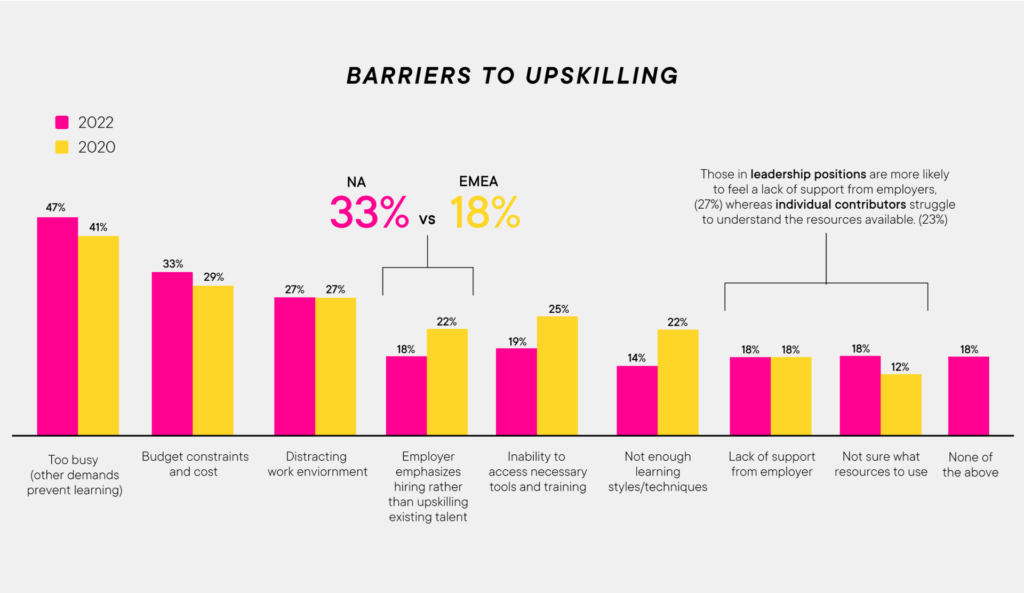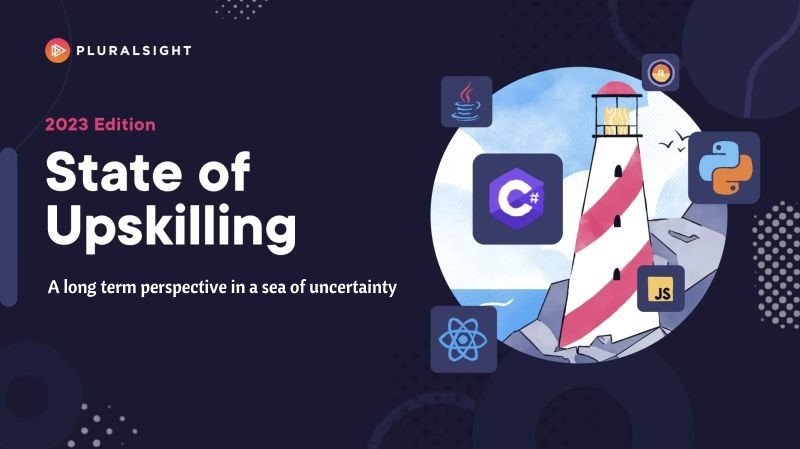
If you’re in the tech industry, you’ve probably heard the mantra: always be upskilling. Mattias Andersson reveals his step-by-step guide on selecting your next skill to master.
As the tech world evolves, staying relevant is crucial. Whether it’s the rise of ChatGPT and generative AI making you anxious about job security, or simply a desire to stay ahead, constant learning is key.
But the pressing question remains: where should you begin?

Figuring out where to upskill can be a significant source of stress. To borrow a twist on Douglas Adams,
“The number of digital skills you can learn is vast. Hugely vast.”
To make matters worse, this landscape is in constant flux—what was in demand in 2021 might be irrelevant just two years later.
The outcome? Indecision. Enter frantic Google searches and endless Reddit threads, such as:
- What’s the best technology skill or tool to learn this year?
- What tools and skills should I spend my learning time on?
- What is an in-demand tech skill that pays me a lot of money?
Of course, this results in you being bombarded with conflicting opinions and information, trying to find the “right” and “perfect” choice. All of this takes precious time and, in the end, you might not even get a proper answer.
If this is you, you’re not alone. According to Pluralsight’s State of Upskilling report 2023, even though 74% of tech professionals receive some time during the week to learn new tech skills, almost a third of us struggle to figure out what to learn.

As you can see, it’s the second biggest barrier to upskilling (short of finding the time amongst our commitments to actually do it). That’s why having to spend time trying to figure out what to learn is even more painful.
So, what if I told you there are a better way?
As you can see, it’s the second biggest barrier to upskilling (short of finding the time amongst our commitments to actually do it). That’s why having to spend time trying to figure out what to learn is even more painful.
1. Start Learning Something New. Anything!
Seriously. Pick something and just start learning. You can pick something you’re interested in, or just choose at random (flip a coin, roll a dice, close your eyes and pick from a list).
Why? Literally learning anything is more important than not learning. If you’re learning something, you’re moving forward, and you’re better than you were yesterday. You’re not stuck in place, or ever moving backward.
Now, if you’re the kind of person who doesn’t like a completely random approach, you might balk inwardly at the very thought of that. You might say, “But I don’t want to lose time learning something useless.” But that’s where step two comes into play.
2. Thirty Minutes In, Ask Yourself Some Questions
Are you enjoying the process? Is what you’re learning interesting to you? Does it seem like this thing you’re learning could be valuable, sometime? And, to sum that all up, do you feel like you’re getting value out of the learning experience?
If you are getting value, then you’re on the right track! But if not, then try something new — a new course, a different medium, or maybe a different subject entirely. Use what you learned about your learning experience to make the next one better! And just because something is considered the “best” skill in tech this year doesn’t necessarily mean it’s your cup of tea! For instance, you might find you don’t have a great love for machine learning, but you do have an interest in cybersecurity.
By repeating this approach, you can seek out better opportunities for investing your time. It’s also a lot more efficient than spending ages doing research and trying to find the “correct” thing to learn, only to get started and find out it’s not for you.
3. Plan Your Next Step From What Works
Once you’ve found something you like and that feels like it will be a good investment of your time to continue learning, you can see what it connects to. Those connections give you an idea if it’s an interesting or potentially profitable skill.
Again, it’s time to ask yourself some questions: What positions in the tech industry currently use that skill? Do those roles interest you? What other things can you learn that are related to the first thing you learned? Can you start fleshing that skill set out, spreading out your learning to a related area to get enough competence to move into a position in that field?
All of this gives you direction. What seemed like a random approach is actually a way to get you the information you need to guide yourself forward, in a way that’s customized to what you enjoy and find interesting, not what everyone else says you should do.

4. If You Don’t Like a Random Approach, Use the Job Postings
One approach that can help you narrow down your learning choices a bit more than the roll of a dice is by checking the postings for jobs in your area. Pick ten, then pick the one that sounds the most interesting—something you think you’d like to do. Look at the list of technologies and skills the role requires, and pick one you don’t know.
Spend some time looking into that thing—again, maybe just thirty minutes—and then go to step 2, above. Keep doing that until you find the one that’s most interesting to you. By going through this process, you might discover “Oh, this particular job wasn’t as interesting as I thought it would be,” or perhaps the opposite. You’ll also start fleshing out all the little skills you’d need to be successful at that job, and understanding how the position works.
This also works for internal job postings, such as promotion opportunities. You can even look at the position you currently hold—especially if you’ve got a co-worker with a similar position to you and they’re back-filling the role. What skills and experience do they have that you don’t have?
This is an important test to run, because you might be in a job where you no longer meet the qualifications for your own position! Shoring up these gaps first is a good way to both improve your job security and make yourself promotable, again.
5. If You’re Nervous About a Skill Deficiency, Make It a Priority.
Everyone’s got that niggling thing they know they could probably be a bit better about in their job, or that new tool or skill they’ve heard about that seems a bit daunting. In fact, according to the latest research, the vast majority of technologists don’t feel completely confident in major tech skill areas. I mean, I myself don’t feel completely confident in even my areas of greatest expertise and experience because everything keeps moving so fast and I have to work hard to keep up! I always have to double-check what I’m doing against the latest advancements.
If that describes you, too, then use that uncomfortable feeling to your advantage. Tackle it head on, and make learning that thing your priority—whatever concerns you the most.
There’s also another bonus to this approach: If everyone else is too daunted to learn about that technology and you’re the only one who does, you’re in a prime position to be the only subject-matter expert on that thing in your business.
Remember this applies to soft skills as well! If you’re great at technology but struggle to communicate or collaborate, there are courses and resources to help you.

Keep Moving Forward and Beating “Technology Inflation”
You can think of technology as an inflationary thing, where the knowledge you need to stay relevant slowly creeps up over time (much like the cost of living!). Upskilling is a way to beat that inflation. So the question becomes “Am I learning enough to beat that inflation?” That’s why it’s important to keep learning new things, and looking for better investment opportunities.
Your Mission, Should You Choose to Accept It…
Act now. Pick an online course, a hands-on lab, a tutorial, or any other learning resource. It can be from a tech education provider, on Youtube, or the official documentation for a tool. Just give it your attention for 30 minutes or so, and start learning! Make yourself more awesome than you were yesterday!
Credit: Mattias Andersson
Source: Pluralsight
- September 19, 2024
- By:tuyosnet23
- Categories:Development and Learning
- no comments

